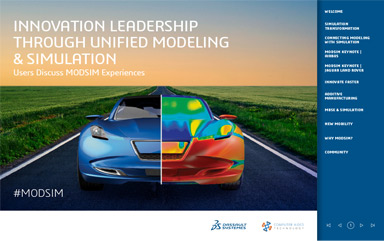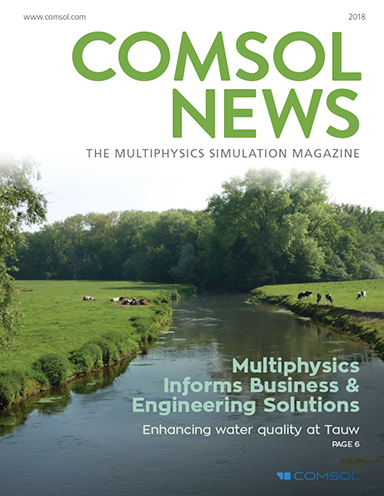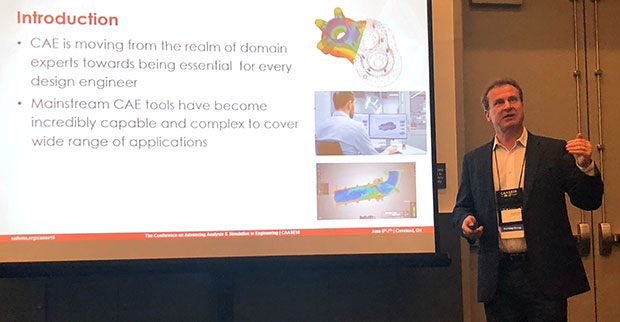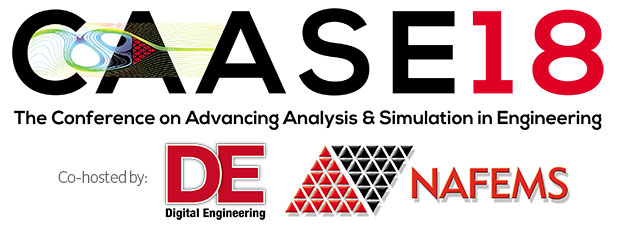Latest in Simulate
Latest Resources

Latest Resources

Simulate Resources


Latest News
June 29, 2018
People want software to be FedEx fast and Disney friendly,” said Jon Aldred, VP of Product Management at HBM Prenscia during his presentation at the 2018 Conference on Advancing Analytics and Simulation in Engineering (CAASE), co-sponsored by NAFEMS and Digital Engineering.
Simulation and analysis software has not built a reputation for being particularly fast or easy to use. It is, however, faster, easier and cheaper than setting up and running physical tests for every design iteration. The catch to the democratization of simulation—making its use widespread throughout an organization—has been the inherent complexity of simulation analysis coupled with the computing power needed to efficiently run large, complex simulations.

Seb Dewhurst, director of Business Development for EASA, makes a presentation on the democratization of simulation at CAASE 18.
Vendors have devised a number of software solutions to the simulation democratization problem, chief among them are apps or template approaches to simulate specific phenomena within a constrained set of variables. In one proposed workflow, analysts are involved in creating the apps, setting them up to allow their colleagues to adjust inputs like temperature or loads within specific ranges and get a result. Because the analyst determines the maximum and minimum adjustments, as well as the specific physics being simulated, the results can be trusted while still being useful for design engineers, field sales reps and executives who don't have analysis expertise.
“The major trend we're seeing is breaking out of the little clique, if you will, within companies of people who can do simulation,” said Phil, Kinnane, VP of Business Development at COMSOL, during an interview with DE at CAASE 18. “If the expert at a company that you're always running to to get a simulation done can actually build some type of application or platform that a number, or many of his colleagues—engineers and so forth—can use, then of course you're going to spread the amount of simulation being performed. Quantity can only produce better results for the company.”
COMSOL offers app building from within its COMSOL Multiphysics flagship product. Its COMSOL Server acts as a platform for deploying and running those apps.
This workflow makes perfect sense from a technical standpoint. It takes the expertise of the analyst and allows it to be distributed throughout an organization, freeing up the analyst's time to work on particularly complex simulations. Paired with hardware and service advances that make high-performance computing (HPC) power readily accessible, everyone should have access to the benefits of simulation. (Watch DE's interview with TotalCAE at CAASE 18 to see the types of HPC options and services that are available for simulation.)
However, on the cultural side, analysts are busy, engineers are busy and IT professionals are busy. They may not have the time to learn how to build or use apps and templates, no matter how easy it is or how much time it could save in the long run. Not only that, they may be territorial and not like what they perceive as others moving into their areas of expertise. These aspects of human nature may be obvious or subtle, depending on the innovation environment at a particular organization. Either way, they tend to stall new processes and need to be addressed just like the technical aspects of democratization.
“There are role changes involved in this process,” Malcolm Panthaki told DE during an interview at CAASE. “The best way to overcome those cultural barriers is to A) check out a lot of the use cases that are already online at revolutioninsimulation.org ... and secondly, try it small.”
Panthaki is co-founder of Comet Solutions, which offers a line of SimApps, and was promoting a new website, Revolution in Simulation, as a resource center and community for simulation democratization. Currently, the site is sponsored by organizations that are proponents of the democratization of simulation, including NAFEMS, Comet Solutions, Front End Analytics, VCollab, ASSESS Initiative, EASA, ESRD, and PLM Alliances.
Juan Betts, managing director of Front End Analytics, agrees with Panthaki on how to get started on the path toward democratization.
“Fail small. If you boil the ocean and fail, you won’t try again,” he said during a CAASE panel discussion on democratization hosted by Revolution in Simulation. Later, in an interview with DE at CAASE 18, he expanded on his comments.
“The biggest hurdle is not technology,” he said. “The main problem is our minds. We are creatures of habit, right? 'This is what I've been doing for 20 years, how is that going to affect my job?' The reality is there are tremendous opportunities across the enterprise to create change, and create a differentiated advantage for the company. People need to understand that their roles will change ... but they will be providing more value in the company.”
Focusing on that added value for the company can, in turn, make design engineers and analysts who are proponents of democratization more valuable to the company—as long as those democratization efforts are successful. That's why it's important to start small and work your way toward broader simulation use.
“Democratization becomes a reality when engineers themselves are able to create apps or automated processes without requiring custom IT projects or software development skills,” said Aldred, calling attention to his company's Aqira product during his presentation at CAASE 18. “Democratization must overcome some real practical challenges in order to become a broadly adopted reality.”
View a playlist of all the video interviews DE conducted at CAASE 18.
Subscribe to our FREE magazine, FREE email newsletters or both!
Latest News
About the Author
Jamie Gooch is the former editorial director of Digital Engineering.
Follow DE




